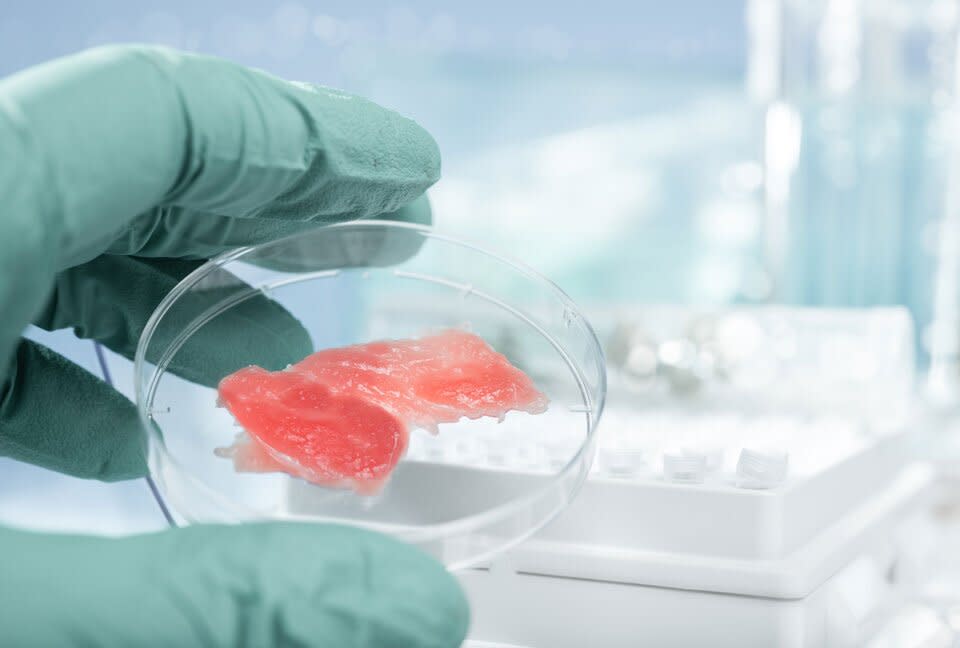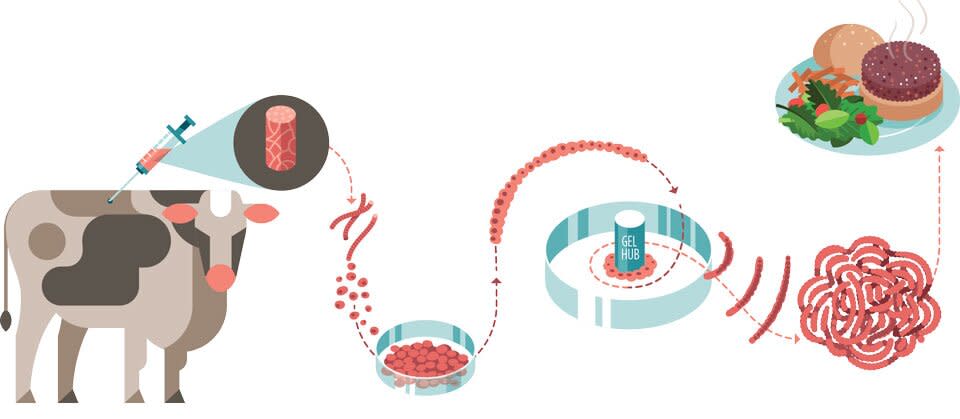Is Lab-Grown Meat the Future of Sustainable Food, or Just Plain Gross?

Meat grown in a lab may be more sustainable than meat taken from an animal, but does a steak straight from a petri dish sound yummy?
Lab grown meat, once just a dream, is here: "Fifty years hence, we shall escape the absurdity of growing a whole chicken in order to eat the breast or wing by growing these parts separately under a suitable medium." Winston Churchill's 1931 forecast is the logic behind lab-grown meat (also called cultured meat, clean meat, in vitro meat and petri meat). Yep, the meat is grown in a lab from cell cultures-without raising or slaughtering an actual animal.
Related: 4 Health Benefits of a Vegan Diet (and What to Watch Out For)
How Is Cultured Meat Made?
Researchers at Maastricht University developed this process for growing beef in a lab, rather than out on the range.

A tiny amount of muscle tissue is taken from the animal. Muscle-specific stem cells are isolated from the tissue sample. Then, the cells are placed in a liquid that "feeds" them. They multiply by 100 trillion-fold over 7 to 8 weeks and start becoming actual muscle cells. Groups of 1.5 million cells fuse into a strand. Next, a gel column is added, and the fibers form a 1 millimeter ring around it. "The muscle cells contract spontaneously, and the ring structure translates that contraction into tension, triggering protein formation," explains researcher Mark J. Post, M.D., Ph.D. The tension bulks up the strand. It continues to "exercise" for 3 weeks. The rings are harvested, cut into strips and layered together with separately grown fat tissue to produce a patty. A 3-ounce burger requires 10,000 of these strips.
This is different from realistic veggie burgers that "bleed." Those are vegetarian, while these burgers are made of real meat. Also, there are no lab-grown meat products on the market.
Yet.
Several companies are racing to bring lab-grown beef, poultry and fish to market (many trying to hit the shelves by the end of 2018), bringing up many questions. Recently, it was announced that the USDA would regulate lab grown meat, a move that some see as a political one by the cattle lobby as a new way to preempt these products being labeled "meat."
There are still a lot of unknowns but we asked experts for their insight on four key aspects of lab-grown meat in terms of health, sustainability, market impact and culinary appeal.
Is Cultured Meat Healthy?
Our Expert: Frank Hu, M.D., Ph.D. Professor and chair of the Department of Nutrition at Harvard T.H. Chan School of Public Health
Are there health concerns about eating this meat?
It's too soon to know, but we need to be vigilant about the potential effects. We learned the lesson from trans fat. It was promoted as a healthier alternative to animal fat because the products were made from vegetable oils. But we now know that partially hydrogenating them made them dangerous for your health. When you play with something on a cellular level, there's a chance for something to go wrong.
Will the nutrition be the same?
We'll have to do a detailed analysis to know the exact nutrient composition of cultured meats-like iron, cholesterol, protein and fat content. In the case of red meat, for example, traditional beef has relatively high amounts of fat. It's good to limit saturated fat, but some of the unsaturated fats in meat are beneficial. But we do know that the cells used to grow lab meat do not grow fat cells, so it has to be added in. While lab-meat producers can control the fat profiles, it's unclear to me whether modifying them can lead to better or worse health outcomes. And we still don't know if it's the saturated fat, or something else in red meat, that causes adverse health effects.
Are there fewer food-safety concerns?
Yes. Bacteria like Salmonella and E. coli live in the guts of animals and can be transmitted through fecal contamination, which poses food-safety issues for regular meat production and consumption. Cultured meat should then be safer because it is produced in a controlled environment.
Is Cultured Meat Sustainable?
Our Expert: Paul Shapiro Author of Clean Meat and former spokesperson and vice president for The Humane Society of the United States
Is cultured meat more sustainable?
Clean meat is better for the planet than raising and slaughtering animals, whether conventional, grass-fed or free-range. When you're raising an entire animal, you have to input all these resources to grow a lot of things that don't end up getting eaten-horns, eyeballs, hooves, brains. When you're growing meat in a lab, you're only creating the calories you need. The resource conservation that occurs in this process is quite promising. It's also likely a better alternative to fishing, particularly for overfished populations. Admittedly, there isn't a lot of research quantifying the environmental impact, but one early study done at Oxford on lab-grown meat showed some astounding results-suggesting it uses up to 96 percent less water and 99 percent less land and produces up to 96 percent less greenhouse gas.
Don't the labs require a lot of energy?
That is a concern. You have to keep the cells at body temperature, requiring constant heat. But while more energy is required for some meats, it still produces far fewer greenhouse gases overall than our current animal-production system. And there's an even bigger advantage to doing cold-blooded animals like fish, which need far less energy because their cells are more accustomed to colder temperatures than those from cows or chickens.
Would lab-grown meat remove the conscience concerns of an omnivore?
Yes. I would call it a no-brainer-literally.
How Does Cultured Meat Impact the Meat Market?
Our Expert: Renske Lynde, Co-founder and managing director of Food System 6, a nonprofit accelerator and think tank for innovative food startups
Is there a market for lab-grown meat?
Consumers aren't accepting of these products. In a recent survey, 2 in 3 people were willing to try lab-grown meat once, yet only 1 in 3 said they'd eat it regularly. And price matters: over 80 percent of consumers would not pay more for cultured meat. With all the R&D required, clean meat is expensive, but if it can eventually achieve price parity, then the real question is going to be about comfort level.
So, why all the buzz?
There's a "silver bullet" aspect from some investors who feel like tech will rule over all other solutions to climate concerns. They feel clean meat is one simple answer to saving the world. It's why we even see big meat companies-like Tyson-investing in this. The realities are much more complex. Add to this the fact that a lion's share of funding is coming from the "vegan mafia"-who have one singular goal around eliminating animal meat-and you have a bit of the reason why there's investment when there might not actually be consumer demand.
What could the industry shifts look like to Big Ag and small-scale ranchers?
In vitro meat is so far away from even being available at scale that it's not a threat to Big Meat. On the smaller-scale production side, if the research bears out that grass-fed systems are actually climate beneficial-meaning they sequester carbon in the soil the animals roam on-then that would make the environmental arguments for "clean meat" moot and the eco-conscious shopper isn't going to buy it.
Is Lab Grown Meat Delicious?
Our Expert: Erica Holland-Toll, Executive chef of the Stanford Flavor Lab, Stanford University, and former Napa Valley/San Francisco restaurant chef
How will lab-grown meats compare in terms of flavor profile and texture?
The only people who I think have tasted it so far are in the lab-grown-meat industry. But I would imagine that it will offer a lot of consistency similar to, say, hothouse tomatoes. It's a recipe, essentially-it's not going to change. And that has upsides and downsides. My hope is that they put thought into what it tastes like, like "this is what people want from chicken." But it's not going to deliver any terroir. Personally, I can't imagine that anything is going to taste as good as a firm, meaty, pasture-raised chicken that has lived outdoors and eaten bugs and fresh produce remnants. I think the food world has offered up plenty of examples to back me up here: farmed shrimp, imitation crab, December strawberries.
Any potential upsides?
There is so much waste that happens through normal cooking. How cool would it be if you could buy the perfect 4-ounce cutlet, perfectly shaped and even all the way through? No trimming, no pounding. I think people would get behind the convenience of that.
Related: Vegetables You Can Eat from Root to Stem
How do we address the ick factor?
We have been primed to accept change in our food systems for a while now. We've already gotten over our ick factor with hot dogs, farmed salmon engineered to be a certain color and grow faster-the list goes on and on. For better or worse, these are all gateways to the acceptance of lab-grown meat.
Watch: How to Pick Healthy Vegetarian Burgers
Read on!
Some additional reporting by Julia Westbrook

